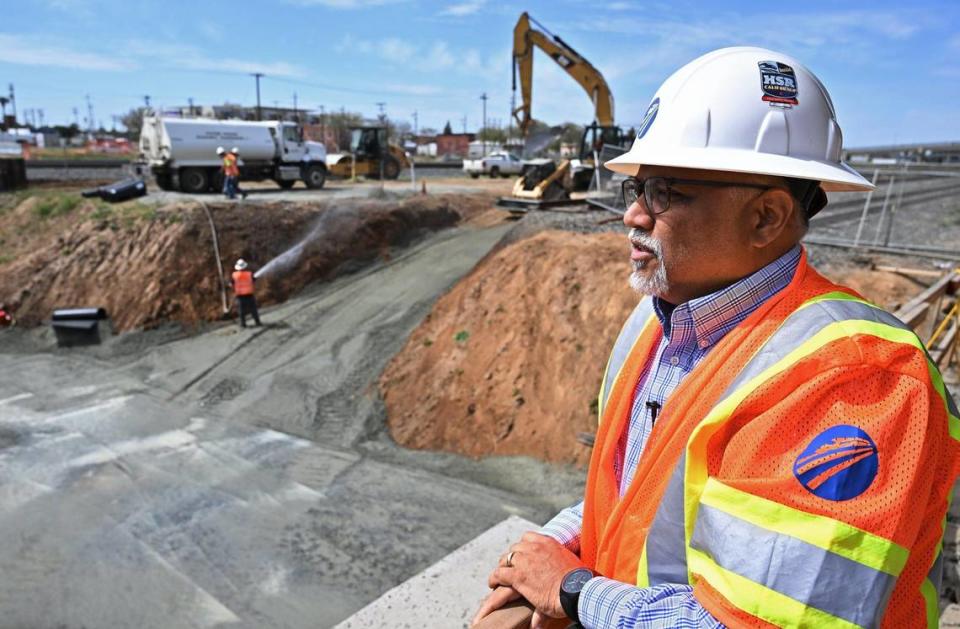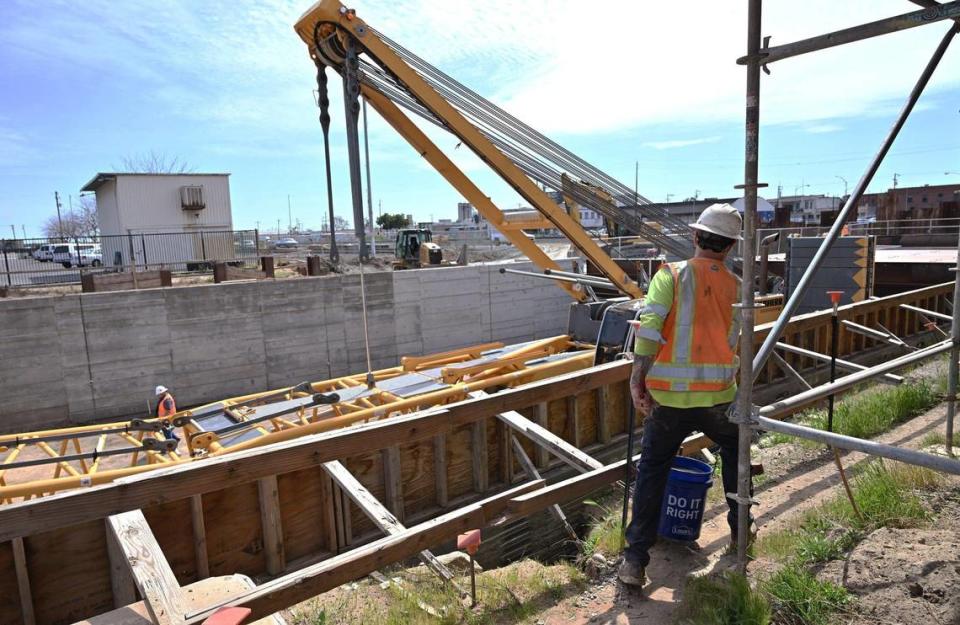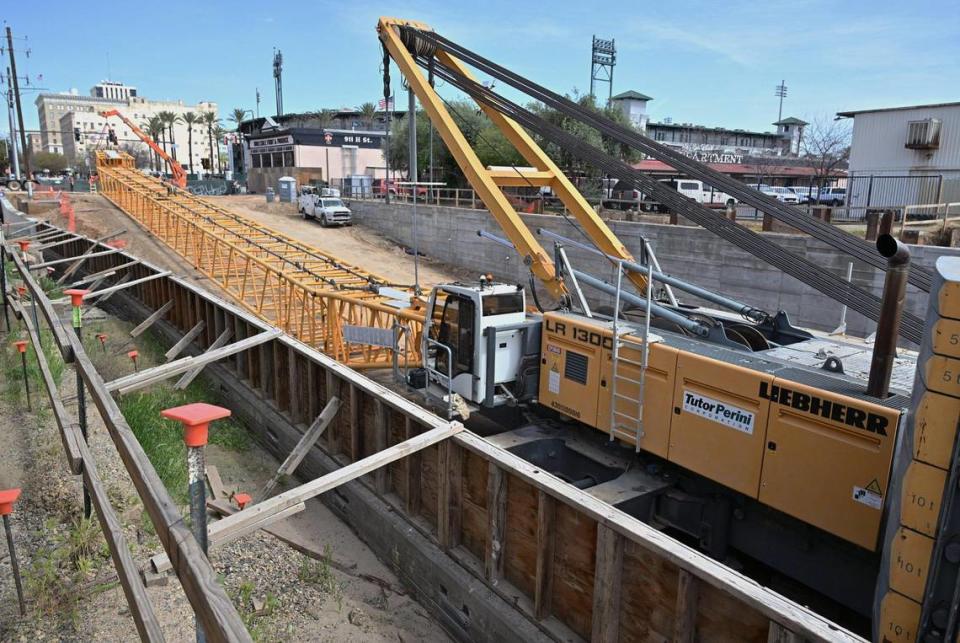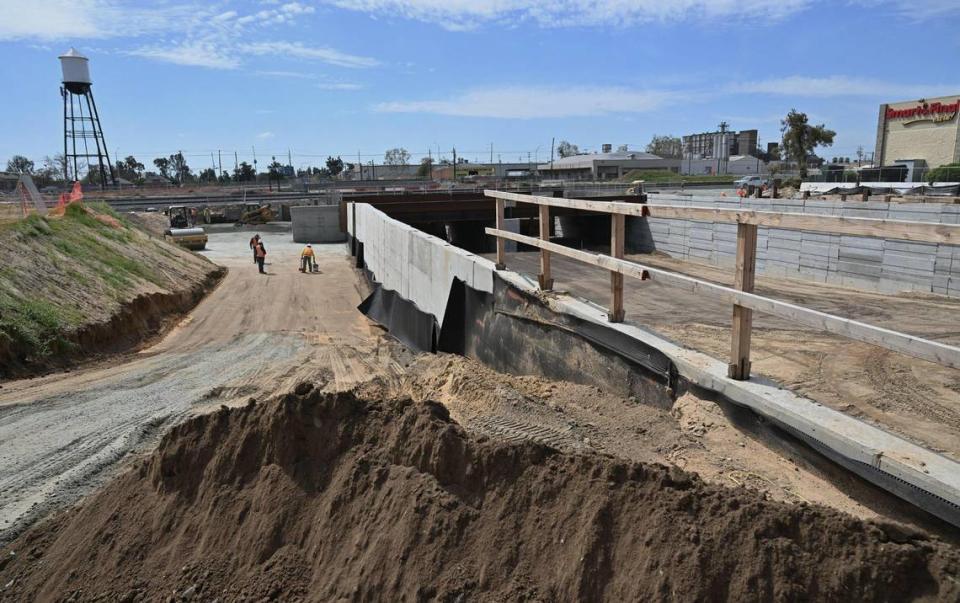Lengthy road closures for high-speed rail worry Fresno mayor: ‘I stuck my neck out’
- Oops!Something went wrong.Please try again later.
For going on seven years, traffic between downtown Fresno and the nearby historic Chinatown district has been disrupted by work on a high-speed rail underpass on Tulare Street. It was a project that was initially expected to take about two years.
A few blocks to the south, a similar construction project at Ventura Street is running months behind schedule after getting started in May 2021.
The delays are becoming a major point of contention for Fresno Mayor Jerry Dyer, despite counting himself as a supporter of California High-Speed Rail Authority’s controversial bullet-train project.
In recent comments to the rail authority’s board of directors, Dyer said that he, along with residents and businesses in Chinatown and downtown, are concerned “about the length of time of some of the road closures that we’ve had, some for eight years.”
And at Church Avenue, which crosses three sets of railroad tracks south of downtown, work on a major new overpass is also falling behind schedule since the road was closed in April 2023.
“Quite frankly, I stuck my neck out as mayor to give authorization to have that street (Church Avenue) closed with the assurance that we would not have delays,” Dyer told the rail agency board, “and now we’re months behind. So that is definitely a concern.”
So the big questions are: What the heck is taking so long? And when the heck will the work be done?
When Tulare Street was first closed in 2017, the original estimate was that the work would take about two years.
When Ventura Street was closed in 2021, it too was estimated as a two-year job.
And when Church Avenue was closed a year ago, completion of a new overpass was originally expected in September 2025.
Garth Fernandez, Central Valley regional director for the California High-Speed Rail Authority, said he is well aware of the frustration over the delays in downtown. But, he added, the challenges that the agency and its prime contractor, Tutor Perini/Zachry/Parsons, have run into at Tulare and Ventura streets have proven to be a cautionary tale — and offered valuable lessons.
Both Tulare and Ventura were closed to allow for crews to build new underpasses between F and H streets to carry traffic under the existing Union Pacific Railroad tracks as well as the future bullet-train tracks, eliminating two at-grade railroad crossings and removing the potential for collisions between automobile traffic and high-speed trains traveling at up to 220 mph.
It’s a task that is, apparently, much easier said than done.

When will Tulare and Ventura streets reopen?
Last summer, when the Federal Railroad Administration awarded a $20 million grant for renovation and restoration of the old Southern Pacific Railroad passenger depot at Tulare and H streets, the future site of a high-speed rail station, Fernandez said he expected the nearby Tulare Street underpass to be completed and the road reopened by now, with Ventura to follow about four to six months later.
In a recent interview and a tour of the downtown construction, Fernandez said an unexpected hiccup with the Union Pacific Railroad has forced more delays in completing and reopening Tulare Street, possibly into this fall and potentially beyond. The same situation also affects when nearby Ventura Street can reopen for traffic.
The latest issue involves the schedule for Union Pacific’s construction crews to do the work of tying in new tracks from a temporary detour that opened in 2022 back to the mainline structure that’s nearly completed. “We had UP’s crews scheduled to come back (in March), and it takes about two to two-and-a-half months to put their tracks back in,” Fernandez told The Bee. “They have to do the work” because it is the railroad’s main north-south line through the San Joaquin Valley, “and we don’t get to work on the main line.”
Both Tulare and Ventura involve not only excavating the path of the underpasses, but also three separate structures for each of the streets:
New G Street bridges now open to traffic above each underpass.
Temporary detour tracks, known in the rail industry as “shoo-fly” tracks, on which Union Pacific’s freight trains run over both Tulare and Venture during the construction stages. UP trains have been using the shoo-fly tracks since 2022. Those shoo-fly tracks are in the alignment of the future high-speed rail line.
A new set of permanent tracks on which UP trains will run above the underpass once those structures are completed and UP crews do the needed tie-ins to move their trains off of the temporary shoo-fly tracks.
Fernandez said that the rail authority’s original plans, as they were developed in 2016 and 2017, called for building its high-speed rail structures first over Tulare and Ventura streets so they could be used as the shoo fly for the freight railroad. “But UP didn’t necessarily agree with that concept,” he said. By 2017, contractors had already built abutments into the excavation for the high-speed rail structures, “but then we ended up burying them; the railroad wanted the tracks at grade and not on a structure because we designed for a different (weight) load than them.”
Each change in design or engineering for the underpasses and the rail structures proved to be a time-consuming ordeal. “Just to get the shoo fly done, we had to go through nine iterations of back-and-forth with Union Pacific,” Fernandez said. “For every plan submittal, they came back with questions, and every submittal took maybe 45 days for them to review it.”
But, he added, he understands UP’s position, since the track is part of the freight railroad’s north-south main line through the San Joaquin Valley: “The railroad is just protecting its interests.”
Now, once the high-speed rail contractor finishes a few remaining details on the new mainline freight structure — work that Fernandez said he expects to take about four weeks or so — UP will be able to reschedule its crews to reinstall their main line tracks.
“We think we can be ready with all of (our work) sometime by the end of May, beginning of June, somewhere in that time frame,” Fernandez said. “We are trying to give UP a level of confidence that we can be done by that date so they can schedule their crew.”
“So it depends if UP says June or July or maybe later than that; we don’t have any control over their schedule,” he said, noting that UP’s crews work all across the state.
Once UP crews are on site, it’s expected that their work will take four to six weeks, followed by a “seasoning” period of about a month to make sure the new tracks are ready to carry the heavy freight trains. “We can’t take the shoo-fly track out; it stays until UP is satisfied,” Fernandez said.
What’s left after that, then, is re-excavating and shoring up the now-buried abutments for the future high-speed rail bridge and the walls for the rest of the underpass, a process that Fernandez estimated will take two and a half to three months before the underpass can be open to traffic. Depending on when UP brings its crews back, that could allow for reopening Tulare Street by late 2024 — possibly sooner if UP crews arrive earlier rather than later.
Ventura is on a similar, but not identical, schedule since it’s a slightly longer structure. But in an effort to try to make up for lost time and get the underpasses for both Tulare and Ventura streets open as soon as possible, Fernandez said, “we are trying to figure out how we can open them up and then do the work (on the structure for the future high-speed rail tracks) while live traffic is running below.”
The next major disruption in downtown Fresno will be the closure of Fresno Street between F and H streets, where the existing underpass below the Union Pacific Railroad will be lengthened to also run beneath the future high-speed rail tracks. That closure won’t happen, however, until after Tulare Street is reopened, Fernandez said.
What’s up with Church Avenue?
Construction of a new Church Avenue overpass to carry traffic up and over a confluence of three railroad lines — Union Pacific, BNSF Railway and the San Joaquin Valley Railroad — has similarly proven more complex than the rail authority’s engineers and contractor originally anticipated.
One problem was with a tunnel-boring machine to be used for construction, Fernandez said.
Another was the discovery of a previously unidentified utility line under the railroad tracks, “so we had to pull back completely (and) it did push our schedule back. … But we are committed to revising our strategy, double-shifting, doing what it takes to recover,” Fernandez said. “We have a commitment to the mayor that we are going to be done by the end of 2025.”
A visit to the Church Avenue construction site reveals that embankments, columns and other high-profile structures needed for an overpass have yet to materialize.
“There are certain things we can do before construction, but then the way we have to stage this, there are certain elements that we have to do while we’re in construction,” Fernandez said. As with other overpasses and underpasses up and down the Valley, construction on the structures represents a dance with the freight railroads so that the work does not disrupt their trains.
Collectively, the challenges posed at Tulare and Ventura streets, Church Avenue and other major construction sites for the bullet-train route have taught valuable, if frustrating, lessons for the rail agency.
“In Fresno, (Tulare Street) has been like an anchor around my neck, for lack of a better word, and we need to resolve it,” Fernandez told The Bee.
“In almost every community, we have some not-so-favorable lessons that we have learned,” he said. “Now we are not closing any street until we are fully ready for construction — everything that we need to do to progress the work smoothly.”
That means fully identifying all utilities that need to be relocated and finalizing all the needed third-party agreements with cities, utilities, irrigation districts, railroads or any other agency affected by a construction site. “We want to make sure we can get all of that to a point where we’re resolving all these issues,” Fernandez said, “because once we’re in construction, you don’t want to have to try to resolve any outstanding issues.”





